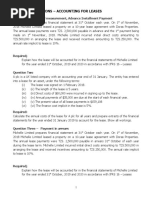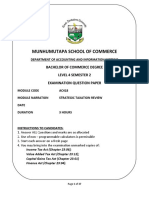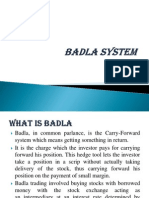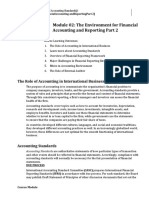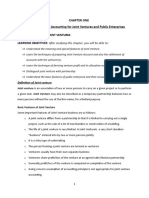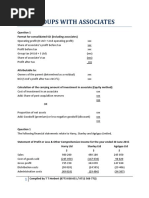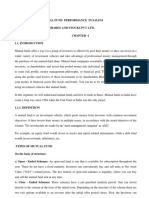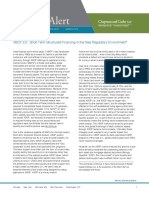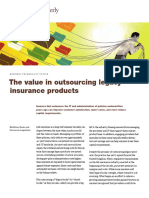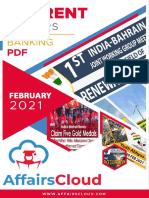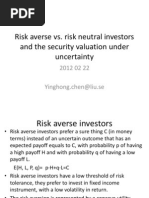IFRS 15 Revenue From Contracts With Customers (2021)
IFRS 15 Revenue From Contracts With Customers (2021)
Uploaded by
Tawanda Tatenda HerbertCopyright:
Available Formats
IFRS 15 Revenue From Contracts With Customers (2021)
IFRS 15 Revenue From Contracts With Customers (2021)
Uploaded by
Tawanda Tatenda HerbertOriginal Title
Copyright
Available Formats
Share this document
Did you find this document useful?
Is this content inappropriate?
Copyright:
Available Formats
IFRS 15 Revenue From Contracts With Customers (2021)
IFRS 15 Revenue From Contracts With Customers (2021)
Uploaded by
Tawanda Tatenda HerbertCopyright:
Available Formats
IFRS 15 REVENUE FROM CONTRACTS
WITH CUSTOMERS
Revenue is income arising in the course of an entity's ordinary activities. Under IFRS 15 the
transfer of goods and services is based upon the transfer of control. Control of an asset is the
ability to direct the use of, and obtain substantially all of the remaining benefits from, the asset.
Revenue recognition (A five step process)
IFRS 15) says that an entity recognises revenue by applying the following five steps:
1. Identify the contract
2. Identify the separate performance obligations within a contract
3. Determine the transaction price
4. Allocate the transaction price to the performance obligations in the contract
5. Recognise revenue when (or as) a performance obligation is satisfied.
Question 1
On 1 December 2018, Willowvale Ltd receives an order from a customer for a computer as well
as 12 months' of technical support. Willowvale Ltd delivers the computer (and transfers its legal
title) to the customer on the same day.
The customer paid $420 upfront. If sold individually, the selling price of the computer is $300 and
the selling price of the technical support is $120.
Required:
Apply the 5 stages of revenue recognition, per IFRS 15, to determine how much revenue
Willowvale Ltd should recognise in the year ended 31 December 2018.
Step 1: Identify the contract with the customer.
A contract with a customer is within the scope of IFRS 15 only when:
1. The parties have approved the contract and are committed to carrying it out.
2. Each party's rights regarding the goods and services to be transferred can be identified.
3. The payment terms for the goods and services can be identified
4. The contract has commercial substance
5. It is probable that the entity will collect the consideration to which it will be entitled.
6. The contract can be written, verbal or implied
1 Compiled by T T Herbert (0773 038 651 / 0712 560 772)
Question 2
Alpha Ltd has a year-end of 31 December 2018.
On 30 September 2018, Alpha Ltd signed a contract with a customer to provide them with an
asset on 31 December 2018. Control over the asset passed to the customer on 31 December
2018. The customer will pay $1m on 30 June 2019.
By 31 December 2018, as a result of changes in the economic climate, Alpha Ltd did not believe
it was probable that it would collect the consideration that it was entitled to.
Required
Determine if there is a contract between the customer and Alpha Ltd in terms of IFRS 15
Step 2: Identify the separate performance obligations
Step two requires the identification of the separate performance obligations in the contract. This
is often referred to as ‘unbundling’, and is done at the beginning of a contract. The key factor in
identifying a separate performance obligation is the distinctiveness of the good or service, or a
bundle of goods or services. A good or service is distinct if the customer can benefit from the
good or service on its own or together with other readily available resources and is separately
identifiable from other elements of the contract.
IFRS 15 requires a series of distinct goods or services that are substantially the same with the
same pattern of transfer, to be regarded as a single performance obligation. A good or service
which has been delivered may not be distinct if it cannot be used without another good or service
that has not yet been delivered. Similarly, goods or services that are not distinct should be
combined with other goods or services until the entity identifies a bundle of goods or services
that is distinct.
Question 3
An entity enters into a contract with a customer to sell a car for $5,000, which includes one year’s
free maintenance.
Required
Determine the separate performance obligations
Question 4
Computech Ltd enters into a contract with a customer to transfer a software licence, perform an
installation service and provide unspecified software updates and technical support (online and
telephone) for a two year period.
Required
2 Compiled by T T Herbert (0773 038 651 / 0712 560 772)
Unbundle the goods and services into separate performance obligations.
Step 3: Determine the transaction price
Step three requires the entity to determine the transaction price, which is the amount of
consideration that an entity expects to be entitled to in exchange for the promised goods or
services. This amount excludes amounts collected on behalf of a third party – for example,
government taxes.
When determining the transaction price, the following must be considered:
variable consideration
significant financing components
non-cash consideration
consideration payable to a customer
Variable consideration
IFRS 15 says that if a contract includes variable consideration (e.g. a bonus or a penalty) then the
entity must estimate the amount it expects to receive, but only include such value within the
transaction price if the likelihood of payment is highly probable. Examples of where a variable
consideration can arise include: discounts, rebates, refunds, price concessions, credits and
penalties.
Question 5
A manufacturer sells one of its products for $500 per unit on credit. To encourage early
settlement the retailer awards its customers a 10 percent early settlement discount provided
that the customer settles within 30 days of buying the goods.
Normal credit terms are 60 days.
Customer 1 pays $40 500 within 30 days of the date of purchase, to settle the amount owing for
90 units bought from the entity.
Customer 2 pays $45 000, 60 days after the date of purchase, to settle the amount owing for 90
units bought from the entity.
Required
Show the statement of profit or loss extract (5 marks)
Question 6
Taplop supplies laptop computers to large businesses. On 1 July 2015, Taplop entered into a
contract with Thrill Ltd, under which Thrill Ltd was to purchase laptops at $500 per unit. The
3 Compiled by T T Herbert (0773 038 651 / 0712 560 772)
contract states that if Thrill Ltd purchases more than 500 laptops in a year, the price per unit is
reduced retrospectively to $450 per unit. Taplop's year-end is 30 June.
(a) As at 30 September 2015, Thrill Ltd had bought 70 laptops from Taplop. Taplop therefore
estimated that Thrill Ltd's purchases would not exceed 500 in the year to 30 June 2016, and
Thrill Ltd would therefore not be entitled to the volume discount.
(b) During the quarter ended 31 December 2015, Thrill Ltd expanded rapidly as a result of a
substantial acquisition, and purchased an additional 250 laptops from Taplop. Taplop then
estimated that Thrill Ltd's purchases would exceed the threshold for the volume discount in
the year to 30 June 2016.
Required
Calculate the revenue Taplop would recognise in:
a) Quarter ended 30 September 2015
b) Quarter ended 31 December 2015
Question 7
Malacha restaurant operates a customer loyalty programme, in terms of which customers earn
one award credit for every $5 that they spent. Only amounts paid in cash qualify for award
credits. Each award credit entitles the customer to a $1 discount on future meals.
It is expected that all award credits will be redeemed and the fair value of each award credit
granted is measured at $1.
Mr. Timba a regular customer to the restaurant has the following information relating to the
months of June and July 2019
Total lunch bills on 30/6/2019- amount settled in cash $140.00
Total lunch bills on 31/7/2019-all available credits redeemed and remainder settled in cash
$60-00
Required
Establish the amount to be recognised as revenue separately for the month of June and July 2019,
taking into consideration deferred amounts if any? [15 marks]
4 Compiled by T T Herbert (0773 038 651 / 0712 560 772)
Variable consideration: Refunds
If a product is sold with a right to return it then the consideration is variable. The entity must
estimate the variable consideration and decide whether or not to include it in the transaction
price.
The refund liability should equal the consideration received (or receivable) that the entity does
not expect to be entitled to.
Financing
If there is a significant financing component, such as when the customer pays more than a year
after receiving the goods or services, then the consideration receivable needs to be discounted
to present value using the rate at which the customer borrows money.
IFRS 15 provides the following indications of a significant financing component:
the difference between the amount of promised consideration and the cash selling price of
the promised goods or services
the length of time between the transfer of the promised goods or services to the customer
and the payment date.
Question 8
On the first day of its annual reporting period an entity sold inventories for $2,000,000 on two
years interest free credit. The entity and its competitors generally allow customers deferred
payment with no interest and hence there are no recent cash transactions from which the entity
could make a reliable estimate of a cash sales price. The entity estimates that the customer would
be able to obtain financing from other sources at an interest rate of 10 per cent year.
Required:
Explain how this transaction should be accounted for in the statement of profit or loss. (5 marks)
NB: If the interest rate is not given then it can be calculated as follows
n
Interest rate = Future value
Cash selling price
OR
1
𝐹𝑢𝑡𝑢𝑟𝑒 𝑣𝑎𝑙𝑢𝑒
= (𝑐𝑎𝑠ℎ 𝑠𝑒𝑙𝑙𝑖𝑛𝑔 𝑝𝑟𝑖𝑐𝑒
) 𝑛 -1
n represents number of years
5 Compiled by T T Herbert (0773 038 651 / 0712 560 772)
Question 9
On the first day of its annual reporting period an entity sold inventories for $2,000,000 on two
years’ interest free credit when the current cash sales price of the goods was $1,652,893.
Required
Show how revenue will be recognised (5 marks)
Non-cash consideration
Any non-cash consideration is measured at fair value. If the fair value of non-cash consideration
cannot be estimated reliably then the transaction is measured using the stand-alone selling price
of the good or services promised to the customer.
Question 10
A retailer sells one of its products for $500 per unit. On one occasion the retailer exchanged 10
units of the product as payment for 10 man-hours of accounting services from a partner of an
international accounting firm. The accounting services received are available to the accounting
firm’s clients at $500 per hour.
Required
At what amount should revenue be recognised? (5 marks)
Consideration payable to a customer
If consideration is paid to a customer in exchange for a distinct good or service, then it should be
accounted for as a separate purchase transaction.
Assuming that the consideration paid to a customer is not in exchange for a distinct good or
service, an entity should account for it as a reduction in the transaction price.
Step 4: Allocate the transaction price to the performance obligations.
Where a contract contains more than one distinct performance obligation a company allocates
the transaction price to all separate performance obligations in proportion to the stand-alone
selling price of the good or service underlying each performance obligation. If the good or service
is not sold separately, the company would have to estimate its stand- alone selling price.
So, if any entity sells a bundle of goods and/or services which it also supplies unbundled, the
separate performance obligations in the contract should be priced in the same proportion as the
unbundled prices.
Question 11
Speedy Motors Ltd entered into an agreement with a customer for the sale of a motor vehicle
with three years of service for a total sum of $30,000. It is also possible for a customer to purchase
6 Compiled by T T Herbert (0773 038 651 / 0712 560 772)
a motor vehicle from Speedy Motors without a service plan for a stand-alone price of $27,000.
The company regularly sells 3-year service plans to customers on a stand-alone basis for $2,300.
Required
Show the allocation of the transaction price between the components of the contract
Allocation of transaction price where there is a discount
If a customer is offered a discount for purchasing a bundle of goods and services, then the
discount should be allocated across all performance obligations within the contract in proportion
to their stand-alone selling prices (unless observable evidence suggests that this would be
inaccurate).
Question 12
On 1 January 2018 Ford Motors entered into a contract to supply a motor vehicle to Soft Ltd. The
seller agrees to maintain the motor vehicle during over a three year period. The total contract
cost is $36,000.
If sold separately it has been determined that the standalone price for the supply of the motor
vehicle is $32,000 and the standalone price for the maintenance services is $8,000.
Required:
Show the allocation of the transaction price between the components of the contract
Question 13
Shrink Ltd sells a machine and one year’s free technical support for $100,000. The sale of the
machine and the provision of technical support have been identified as separate performance
obligations. Shrink Ltd usually sells the machine for $95,000 but it has not yet started selling
technical support for this machine as a stand-alone product. Other support services offered by
Shrink Ltd attract a mark-up of 50%. It is expected that the technical support will cost Shrink Ltd
$20,000.
Required:
How much of the transaction price should be allocated to the machine and how much should be
allocated to the technical support?
Question 14
On 1 September 2017 Selby Ltd sold a machine including two year’s technical support for
$396,000. It usually sells the machine for $300,000 but does not sell technical support for this
machine as a stand-alone product. Other support services offered by Selby Ltd earn a mark-up of
40%. It is expected that the technical support will cost Selby Ltd $50,000 per year.
7 Compiled by T T Herbert (0773 038 651 / 0712 560 772)
Required: How much revenue was earned by Selby in the year to 31 December 2017?
Step 5: Recognise revenue when (or as) a performance obligation is satisfied.
The entity satisfies a performance obligation by transferring control of a promised good or service
to the customer. A performance obligation can be satisfied at a point in time, such as when goods
are delivered to the customer, or over time.
Question 15
The financial controller of Femphr Ltd. has asked you, a trainee accountant, to research the
implications for the company arising from the implementation of the new international financial
reporting standard on Revenue i.e. IFRS 15 - Revenue from contracts with customers. The core
principle of IFRS 15 is that an entity recognises revenue to depict the transfer of promised goods
or services to customers in an amount that reflects the consideration to which the entity expects
to be entitled in exchange for those goods or services. This core principle is delivered in a five-
step model framework.
REQUIREMENT:
Prepare a report for the financial controller in which you:
(a) (i) Identify and briefly explain each of the five steps for revenue recognition. (5 Marks)
(ii) Explain what is meant by the term ‘performance obligations’ in a contract? (2 Marks)
(iii) Advise how a good or service can be defined as ‘distinct’. (2 Marks)
(b) Femphr Ltd. enters a contract with a customer to supply a licence for a standard software
product. The company will also install the software, provide updates to the software and
technical support for a number of years. Fenwood Ltd. sells the licence and technical support
separately, the software will continue to operate without the software updates and the
installation of the software will be sub-contracted to a number of approved installers
throughout the country.
REQUIREMENT:
In light of your answer to part (a) above, identify the good/services which are distinct in the above
contract. (4 Marks)
(c) Fenwood Ltd. entered into a contract with a customer to sell its product for $200 per unit for
the 2017 calendar year. If the customer was to purchase more than 1,200 units in the year,
the price would decrease to $150 per unit. Fenwood Ltd. did not believe at the date of the
contract being initiated that the customer would purchase more than 1,200 units from it due
to previous trading patterns with this customer. However, on 1 October 2017, Fenwood Ltd.
formed the view that the customer would meet or exceed the 1,200 units threshold based on
its sales of 1,100 units by that date. The customer had purchased 500 units on that date and
8 Compiled by T T Herbert (0773 038 651 / 0712 560 772)
informed management of Fenwood Ltd. that it would be placing a further order of 200 units
on 1 December 2017. This customer had purchased 600 units by 30 June 2017.
REQUIREMENT
Using journal entries, show how Fenwood Ltd. accounts for its revenue to the customer in the
period from 1 January 2017 to 30 June 2017 and in the period from 1 July 2017 to 31 December
2017. (7 Marks)
Question 16
IFRS 15 - Revenue from Contracts with Customers was issued in May 2014, and is effective for
accounting periods beginning on or after 1 January 2018. However, early adoption is permitted.
The IFRS requires a 5-step approach to determining the amount of revenue to be recognised by
an entity.
(i) On 31 March 2018, Derek Plc signed a contract to supply 500 units of product at an agreed
price of $1,000 per unit. 300 units were delivered at that date, with the remainder to be
delivered on 1 June 2018. It was agreed that the customer would have extended credit
terms of 12 months from the date of delivery. Derek Plc’s cost of capital is 10%.
(ii) During the year ended 31 March 2018, Derek Plc took payment in advance for the supply
of 2,000 hotel room-nights to customers at €100 per room per night. Only 400 of these
had been occupied by 31 March 2018. The amounts paid by the customers are non-
refundable unless the company fails to provide the agreed accommodation.
Assume Derek Plc has decided to adopt IFRS 15 for year ended 31 March 2018.
REQUIREMENT:
(a) Outline the general principles and the 5-step approach to recognising revenue as set out by
IFRS 15 – Revenue from Contracts with Customers. (10 marks)
(b) In each scenario above, calculate the amount of revenue to be recognised in the financial
statements of Derek Plc for year ended 31 March 2018. Show the journal entries required to
record each transaction. Justify your answer in each case. (10 marks)
[Total: 20 Marks]
Question 17
An entity enters into a contract with a customer on 1 January 2014 to sell Product A for $100 per
unit. If the customer purchases more than 1,000 units of product A in a calendar year, the
9 Compiled by T T Herbert (0773 038 651 / 0712 560 772)
contract specifies that the price per unit is retrospectively reduced to $90 per unit. Consequently,
the consideration in the contract is variable.
For the first quarter ended 31 March 2014, the entity sells 75 units of Product A to the customer.
The entity estimates that the customer purchases will not exceed the 1,000-unit threshold
required for the volume discount in the calendar year.
In May 2014, the entity’s customer acquires another company and in the second quarter ended
30 June 2014 the entity sells an additional 500 units of Product A to the customer. In the light of
the new fact, the entity estimates that the customer’s purchases will exceed the 1,000-unit
threshold for the calendar year and therefore it will be required to retrospectively reduce the
price per unit to $90.
Required
a) How much revenue the entity should recognise according to the requirements of IFRS 15:
i) in the quarter ended 31 March 2014 [4 marks]
ii) in the quarter ended 30 June 2014 [4 marks]
b) The principles in IFRS 15 are applied using five steps
Required
Briefly describe each step the entity should satisfy when measuring and recognising revenue and
the related cash flows from contracts with customers [17 marks]
Question 18
(a) What is the core principle of IFRS 15? [5 marks]
(b) IFRS 15 applies when there is a contract with a customer. What are the 5 criteria which must
be satisfied for there to be a contract with a customer in terms of IFRS 15? [5 marks]
(c) Agricore Limited sold 500 standard drums of cotton pest control chemicals to a customer in
Sabi Valley in Chipinge for a contractually agreed amount of $500 000. This is Agricore’s first
sale to a customer in Chipinge and the region is experiencing significant economic difficulty.
Agricore believes that the economic conditions will improve in future and that by establishing
a trading relationship now with the customer, sales volumes will be enhanced. However for
the first contract, Agricore does not expect that the customer will be able to pay the full
amount of the contractually agreed price. Consequently, Agricore determines that it expects
to offer a 50% discount to its customer.
REQUIRED:
Looking at the above mentioned scenario, how much will be accounted for under IFRS 15 by
Agricore Limited? Briefly motivate your answer. [5 marks]
10 Compiled by T T Herbert (0773 038 651 / 0712 560 772)
Performance obligations satisfied at a point in time
A performance obligation not satisfied over time will be satisfied at a point in time. This will be
the point in time at which the customer obtains control of the promised asset and the entity
satisfies a performance obligation.
Some indicators of the transfer of control are:
1. The entity has a present right to payment for the asset.
2. The customer has legal title to the asset.
3. The entity has transferred physical possession of the asset.
4. The significant risks and rewards of ownership have been transferred to the customer.
5. The customer has accepted the asset.
Performance obligations satisfied over time
An obligation satisfied over time will meet ONE of the following criteria:
1. The customer simultaneously receives and consumes the benefits as the performance takes
place.
2. The entity's performance creates or enhances an asset that the customer controls as the asset
is created or enhanced.
3. The entity's performance does not create an asset with an alternative use to the entity and
the entity has an enforceable right to payment for performance completed to date.
If a performance obligation is satisfied over time, then revenue is recognised over time based on
progress towards the satisfaction of that performance obligation or completion. An entity must
be able to reasonably measure the outcome of a performance obligation before the related
revenue can be recognised.
Methods of measuring progress towards completion
Progress towards completion may be measured using either
1. An input method (based on costs incurred as a proportion of total expected cost) or
2. an output method (based on value of work completed as a proportion of total contract price).
Input method
Input methods recognise revenue on the basis of the entity's inputs, such as labour hours,
resources consumed, and costs incurred.
Contract costs to date
Progress towards completion = Total Estimated Contract costs x 100
11 Compiled by T T Herbert (0773 038 651 / 0712 560 772)
Output method
Output methods recognise revenue on the basis of the value to the customer of the goods or
services transferred. They include surveys of performance completed, appraisal of units
produced or delivered etc.
Value of work certified
Progress towards completion = x 100
Contract Price
Question 19
The following information relates to a construction contract:
$
Contract price 500,000
Costs to date 300,000
Estimated costs to completion 100,000
Value of work certified to date 400,000
Required
Determine the revenue to be recognised using the following:
a) input method
b) output method
Performance obligations satisfied over time Summary of accounting treatment Statement of
profit or loss
Revenue and costs
(i) Sales revenue and associated costs should be recorded in profit or loss as the contract activity
progresses
(ii) Include an appropriate proportion of total contract value as sales revenue in profit or loss.
(iii) The costs incurred in completing that amount of the performance obligation are matched
with this sales revenue, resulting in the reporting of results which can be attributed to the
proportion of work completed.
(iv) Sales revenue is the value of work carried out to date.
Statement of financial position
The following should be recognised in the SFP
(a) Contract asset (presented separately under current assets)
Costs incurred to date xxx
Add: Profit recognised to date or less: recognised losses xxx
xxx
12 Compiled by T T Herbert (0773 038 651 / 0712 560 772)
Less: Invoices raised to date /progress billings to date (xxx
Amounts due from debtors xxx
)
(b) Receivables
Invoices raised to date/progress billings to date xxx
Less: Cash received to date/progress payments to date (xxx)
Unpaid invoices / Trade receivable xxx
(c) Contract liability
Where (a) gives a net amount due to the customer this amount should be included as a contract
liability, presented separately under current liabilities.
Where progress cannot be reasonably determined
In some circumstances, such as in the early stages of a contract, it may not be possible to
reasonably measure the outcome of a performance obligation, but the entity expects to recover
the costs incurred. In these circumstances, revenue is recognised only to the extent of costs
incurred.
Where progress cannot be reasonably determined
In some circumstances, such as in the early stages of a contract, it may not be possible to
reasonably measure the outcome of a performance obligation, but the entity expects to recover
the costs incurred. In these circumstances, revenue is recognised only to the extent of costs
incurred.
Question 20
Pride Ltd is company with a 31 December financial year end and it entered into 3 contracts which
involved the rendering of services to different clients.
Case 1
By year end the work had just started and it was not possible to determine the outcome of the
contract reliably. The contract price was $10,000 while expenses amounting to $1,450 had been
incurred to date. The company considered the expenses to be recoverable.
Case 2
The contract started off well and the company spent $2,130 on the preliminary stages of the
work. The total value of the contract was $15,000. The contractee is facing financial problems
and has indicated that the contract may have to be cancelled.
13 Compiled by T T Herbert (0773 038 651 / 0712 560 772)
Case 3
A lot of work has been done on this contract which has a total value of $25,000. Total costs
incurred to date amount to $15,000 while the total cost of completing the work is expected to
be $20,000. These amounts have been measured reliably.
Requirement
Determine the revenue to be recognised in the above unrelated cases
Common types of transactions
Warranties
If a customer has the option to purchase a warranty separately from the product to which it
relates, it constitutes a distinct service and is accounted for as a separate performance obligation.
This would apply to a warranty which provides the customer with a service in addition to the
assurance that the product complies with agreed-upon specifications.
If the customer does not have the option to purchase the warranty separately, for instance if the
warranty is required by law, that does not give rise to a performance obligation and the warranty
is accounted for in accordance with IAS 37.
Principal versus agent
An entity must establish in any transaction whether it is acting as principal or agent. It is a
principal if it controls the promised good or service before it is transferred to the customer. When
the performance obligation is satisfied, the entity recognises revenue in the gross amount of the
consideration to which it expects to be entitled for those goods or services.
It is acting as an agent if its performance obligation is to arrange for the provision of goods or
services by another party. Satisfaction of this performance obligation will give rise to the
recognition of revenue in the amount of any fee or commission to which it expects to be entitled
in exchange for arranging for the other party to provide its goods or services.
Indicators that an entity is an agent rather than a principal include the following:
(a) Another party is primarily responsible for fulfilling the contract.
(b) The entity does not have inventory risk before or after the goods have been ordered
by a customer, during shipping or on return.
(c) The entity does not have discretion in establishing prices for the other party's goods or
services and, therefore, the benefit that the entity can receive from those goods or
services is limited.
(d) The entity's consideration is in the form of a commission.
(e) The entity is not exposed to credit risk for the amount receivable from a customer in
exchange for the other party's goods or services.
14 Compiled by T T Herbert (0773 038 651 / 0712 560 772)
Question 21
A manufacturer sells goods to its customers through an intermediary.
The intermediary holds the goods on consignment from the manufacturer.
The intermediary instructs may return any goods not sold to the manufacturer. The manufacturer
instructs the intermediary to sell the goods at $100 per unit.
The intermediary deducts fixed commission of $10 for each unit sold and transfers the balance
($90) to the manufacturer. If goods are found to be defective, the customers must return the
goods to the manufacturer for repair or replacement.
Required
How much revenue should be recognised? 5 marks
Repurchase agreements
Under a repurchase agreement an entity sells an asset and promises, or has the option, to
repurchase it. Repurchase agreements generally come in three forms.
(a) An entity has an obligation to repurchase the asset (a forward contract).
(b) An entity has the right to repurchase the asset (a call option).
(c) An entity must repurchase the asset if requested to do so by the customer (a put option)
An entity has an obligation to repurchase the asset (a forward contract)
In the case of a forward contract the customer does not obtain control of the asset, even if it has
physical possession. The entity will account for the contract as:
(a) A lease in accordance with IFRS 16, if the repurchase price is below the original selling price;
or
(b) A financing arrangement if the repurchase price is equal to or greater than the original
selling price. In this case the entity will recognise both the asset and a corresponding
liability.
Question 22
A construction company that mould bricks sells bricks to a bank for $1,000,000 and
simultaneously enter into an agreement to repurchases the brick from the bank for $1,080,000
one year later. On the date of entering into the transaction, the fair value of the bricks was
$2,000,000 and the manufacturer’s incremental borrowing rate approximated 8 per cent per
year.
Required
Show how revenue, if any, should be recognised (5 marks)
15 Compiled by T T Herbert (0773 038 651 / 0712 560 772)
An entity has the right to repurchase the asset (a call option)
In the case of a call option the customer does not obtain control of the asset, even if it has
physical possession. The entity will account for the contract as:
a) A lease in accordance with IFRS 16, if the repurchase price is below the original selling price;
or
b) A financing arrangement if the repurchase price is equal to or greater than the original selling
price. In this case the entity will recognise both the asset and a corresponding liability.
An entity must repurchase the asset if requested to do so by the customer (a put option)
If the entity is obliged to repurchase at the request of the customer (a put option), it must
consider whether or not the customer is likely to exercise that option.
If the repurchase price is lower than the original selling price and it is considered that the
customer does not therefore have significant economic incentive to exercise the option, the
contract should be accounted for as an outright sale, with a right of return. If the customer is
considered to have a significant economic incentive to exercise the option, the entity should
account for the agreement as a lease in accordance with IFRS 16.
If the repurchase price is greater than or equal to the original selling price and is above the
expected market value of the option, the contract is treated as a financing arrangement.
Consignment arrangements
When a product is delivered to a customer under a consignment arrangement, the customer
(dealer) does not obtain control of the product at that point in time, so no revenue is recognised
upon delivery.
Indicators of a consignment arrangement include:
(a) The product is controlled by the entity until a specified event occurs, such as the product is
sold on, or a specified period expires.
(b) The entity can require the return of the product, or transfer it to another party.
(c) The customer (dealer/distributor) does not have an unconditional obligation to pay
for the product.
Required accounting treatment
The following apply where it is concluded that control of the inventory has been transferred to
the dealer.
(a) The inventory should be recognised as such in the dealer's statement of financial
position, together with a corresponding liability to the manufacturer.
16 Compiled by T T Herbert (0773 038 651 / 0712 560 772)
(b) Any deposit should be deducted from the liability and the excess classified as a trade
payable.
Where it is concluded that control of the inventory has not been transferred to the dealer, the
following apply.
(a) The inventory should not be included in the dealer's statement of financial position until
the transfer of control has taken place.
(b) Any deposit should be included under 'other receivables’
Question 23
A manufacturer sells goods to its customers through an intermediary.
The intermediary holds the goods on consignment from the manufacturer.
The intermediary instructs may return any goods not sold to the manufacturer. The manufacturer
instructs the intermediary to sell the goods at $100 per unit.
The intermediary deducts fixed commission of $10 for each unit sold and transfers the balance
($90) to the manufacturer. If goods are found to be defective, the customers must return the
goods to the manufacturer for repair or replacement.
Required
How much revenue should be recognised? 5 marks
Bill-and-hold arrangements
Under a bill-and-hold arrangement goods are sold but remain in the possession of the seller for
a specified period, perhaps because the customer lacks storage facilities.
An entity will need to determine at what point the customer obtains control of the product. For
some contracts, control will not be transferred until the goods are delivered to the customer.
For others, a customer may obtain control even though the goods remain in the entity's
physical possession. In this case the entity would be providing custodial services (which may
constitute a separate performance obligation) to the customer over the customer's asset.
For a customer to have obtained control of a product in a bill and hold arrangement, the
following criteria must all be met:
The reason for the bill-and-hold must be substantive (for example, requested by the customer)
(a) The reason for the bill-and-hold must be substantive (for example, requested by the
customer)
(b) The product must be separately identified as belonging to the customer.
(c) The product must be ready for physical transfer to the customer.
(d) The entity cannot have the ability to use the product or to transfer it to another
customer.
17 Compiled by T T Herbert (0773 038 651 / 0712 560 772)
Question 24
An entity enters into a contract with a customer on 1 January 2018 for sale of a machine and
spare parts. It takes two years to manufacture these and on 31 December 2019 the customer
pays for both the machine and the spare parts but only takes physical possession of the
machine. The customer inspects and accepts the spare parts but requests that they continue to
be stored at the entity's warehouse.
Required
How should the contract be accounted for?
Summary of revenue transactions
Transaction Timing of Revenue Recognition
(1) Bill and Hold Sales When the buyer takes title
(2) Goods Shipped Subject to Conditions
(a) installation & inspection When the buyer accepts delivery and installation &
inspection is completed.
(b) on approval When the buyer formally accepts the shipment
(c) with limited right of return When the goods were delivered and time for return
lapsed.
(d) consignment sales After the buyer sells goods to the final customer.
(e) cash on delivery (COD) sales When delivery is made and cash is received by the
seller
(3) Lay Away Sales When the delivery is made. However, when
experience indicates that most such sales are
consummated, revenue may be recognized when a
significant deposit is received provided the goods
are on hand, identified and ready for delivery to the
purchaser.
(4) Tuition fees Over period of instruction.
Revenue shall be recognized on the following bases:
Transaction Revenue Recognition
(1) Interest Shall be recognized using the effective interest method as set out in IAS 39
(2) Royalties Shall be recognized on an accrual basis in accordance with the substance of the
relevant agreement
(3) Dividends Shall be recognized when the shareholder’s right to receive payment is
established.
18 Compiled by T T Herbert (0773 038 651 / 0712 560 772)
Question 25
The following transactions occurred during the year ending 31 December 2019
Note $
Sales [including Value Added Tax (VAT) at 15%] 464 600
Installments received on lay bye sales 1 20 000
Consignment sales of all inventory on consignment 2 40 000
Cash on Delivery (COD) sales (including VAT at 15%) 3 26 500
Trade discount received 30 000
Installation fees received 4 18 000
Royalties received 5 2 750
Notes
1. Past experience shows that 95% of all lay bye sales are completed. Significant deposits have
been made on sales of $25 000.
2. The “inventory on consignment at cost account” shows a balance of $5,000. All
consignment sales are made by agents and sales are made at a gross profit of 20% on selling
price. The $40,000 excludes VAT.
3. The balance on the receivables account for the COD sales at the end of the year was $5 250
and at the beginning of the year was $4 625.
4. Included in the amount of installation fees is an amount of $100 for an installation which
has not yet started on 31 December 2019.
5. Annual royalties according to the agreement should be $3 000.
REQUIRED
Calculate the total revenue to be recognised for the year ending 31 December 2019 in
accordance with the requirements of IFRS 15.
Question 26
National Centre is a retailer of electrical goods. The following transactions took place during the
year-ended 30 June 2020.
$
1. Income from repair services 266 000
2. Sales of equipment 360 500
3. Royalties received in cash 11 800
(Total royalties receivable $14 000)
4. Installation fees received 129 500
This amount includes:
$2 500 in respect of an installation
which has not yet been undertaken.
5. Sale of equipment by National Centre on behalf
of another company. 234 900
19 Compiled by T T Herbert (0773 038 651 / 0712 560 772)
National Centre receives a commission of 10% on all
consignment sales
6. Maintenance contract fees received during 450 000
the year. This amount includes prepaid contract
fees as follows:
i. On 1 July 2019 ($42 300)
ii. 30 June 2020 ($66 200)
7. Course fees received for training technicians 32 760
from other companies. The course will be run
from 1 June to 30 September 2020. $8 400
is still outstanding and is expected to be received in August 2020.
Required:
Calculate the amount of revenue which should be recognised by National Centre for the year
ended 30 June 2020 to comply with IFRS 15.
20 Compiled by T T Herbert (0773 038 651 / 0712 560 772)
You might also like
- Credit Card DetailsDocument4 pagesCredit Card Detailsabdou allalou67% (9)
- ACCA Taxation - Zimbabwe (ZWE) Revision Kit 2022 by T T HerbertDocument77 pagesACCA Taxation - Zimbabwe (ZWE) Revision Kit 2022 by T T HerbertTawanda Tatenda Herbert100% (5)
- ACCA Corporate & Business Law - Zimbabwe (LW-ZWE) Revision Kit 2022 by T. T. HerbertDocument35 pagesACCA Corporate & Business Law - Zimbabwe (LW-ZWE) Revision Kit 2022 by T. T. HerbertTawanda Tatenda HerbertNo ratings yet
- ACCA Corporate & Business Law - Zimbabwe (LW-ZWE) Revision Kit 2022 by T. T. HerbertDocument35 pagesACCA Corporate & Business Law - Zimbabwe (LW-ZWE) Revision Kit 2022 by T. T. HerbertTawanda Tatenda HerbertNo ratings yet
- CHAPTER 6 7 and 8 TAXDocument38 pagesCHAPTER 6 7 and 8 TAXMark Lawrence Yusi100% (1)
- TOP 250+ IFRS Interview Questions and Answers 28 PDFDocument1 pageTOP 250+ IFRS Interview Questions and Answers 28 PDFHafisMohammedSahib100% (1)
- ACCA Corporate & Business Law (LW-ZWE) Study Text 2022 by T. T. HerbertDocument30 pagesACCA Corporate & Business Law (LW-ZWE) Study Text 2022 by T. T. HerbertTawanda Tatenda Herbert100% (1)
- ACCA Corporate & Business Law (LW-ZWE) Study Text 2022 by T. T. HerbertDocument30 pagesACCA Corporate & Business Law (LW-ZWE) Study Text 2022 by T. T. HerbertTawanda Tatenda Herbert100% (1)
- Case Study On Hollow OrganisationDocument4 pagesCase Study On Hollow OrganisationViral MehtaNo ratings yet
- IMS Proschool CFP EbookDocument140 pagesIMS Proschool CFP EbookNielesh AmbreNo ratings yet
- Accounting For LeasesDocument4 pagesAccounting For LeasesSebastian MlingwaNo ratings yet
- Chap 012Document20 pagesChap 012Hemali MehtaNo ratings yet
- Insurance Act 2010 English VersionDocument103 pagesInsurance Act 2010 English VersionTauseen Ibrahim DaiyanNo ratings yet
- Citn New Professional Syllabus - Indirect TaxationDocument95 pagesCitn New Professional Syllabus - Indirect TaxationtwweettybirdNo ratings yet
- IAS 40 Investment Property (2021)Document7 pagesIAS 40 Investment Property (2021)Tawanda Tatenda HerbertNo ratings yet
- Tax Question Bank 2020Document37 pagesTax Question Bank 2020Tawanda Tatenda HerbertNo ratings yet
- Badla SystemDocument11 pagesBadla Systemiamritpalsingh67% (3)
- IFTA CFTeII Mock Exam ENG PDFDocument19 pagesIFTA CFTeII Mock Exam ENG PDFmissmawarlina100% (1)
- IAS 20 Government Grants (2021)Document5 pagesIAS 20 Government Grants (2021)Tawanda Tatenda HerbertNo ratings yet
- Ifrs 5 (2021)Document9 pagesIfrs 5 (2021)Tawanda Tatenda HerbertNo ratings yet
- IAS 19 Employee Benefits (2021)Document6 pagesIAS 19 Employee Benefits (2021)Tawanda Tatenda Herbert100% (1)
- Ias 37 Provisions, Contingent Liabilities & Contingent AssetsDocument12 pagesIas 37 Provisions, Contingent Liabilities & Contingent AssetsTawanda Tatenda HerbertNo ratings yet
- Sage Pastel Accounting Payroll and HR Tax Guide For 2013/2014Document52 pagesSage Pastel Accounting Payroll and HR Tax Guide For 2013/2014Patty PetersonNo ratings yet
- Deloitte Model Half Year Report 31dec2013Document75 pagesDeloitte Model Half Year Report 31dec2013PhillipGaoNo ratings yet
- What Are Accounting PrinciplesDocument3 pagesWhat Are Accounting PrinciplesMarie MirallesNo ratings yet
- Share Based Payments SBRDocument32 pagesShare Based Payments SBRinnocent moonoNo ratings yet
- IAS 16 Property Plant EquipmentDocument4 pagesIAS 16 Property Plant EquipmentMD Hafizul Islam HafizNo ratings yet
- Business Structures in OntarioDocument7 pagesBusiness Structures in OntariocorecorpNo ratings yet
- GStart 2014-1Document33 pagesGStart 2014-1Ahmed IbrahimNo ratings yet
- Chapter Eight: Cost-Volume-Profit AnalysisDocument34 pagesChapter Eight: Cost-Volume-Profit AnalysisBartholomew SzoldNo ratings yet
- MICROFINANCEDocument2 pagesMICROFINANCEYkeOluyomi OlojoNo ratings yet
- Debt To Equity RatioDocument9 pagesDebt To Equity RatioSHRI0588No ratings yet
- MSC Finance Programme Handbook 2023.24Document53 pagesMSC Finance Programme Handbook 2023.24Sam SungNo ratings yet
- Financial Accounting and Reporting 02Document6 pagesFinancial Accounting and Reporting 02Nuah SilvestreNo ratings yet
- Unit 7 - The General Deduction FormulaDocument22 pagesUnit 7 - The General Deduction FormulahavengroupnaNo ratings yet
- FR16 Taxation (Stud) .Document45 pagesFR16 Taxation (Stud) .duong duongNo ratings yet
- How To Read Annual ReportDocument6 pagesHow To Read Annual ReportJkjiwani Acca100% (1)
- ISA 315 - MGT AssertionsDocument5 pagesISA 315 - MGT AssertionsAwaisQureshiNo ratings yet
- UntitledDocument21 pagesUntitleddhirajpironNo ratings yet
- List of the Most Important Financial Ratios: List of Financial Ratios (PDF), Key Financial Ratios: Formulas and Explanations, What are Financial Ratios (Explained Types), Common Financial Ratios: Formula, Importance of Best Financial Ratios: Analysis and Interpretation, Example of Financial Ratio, Formula, List of Profitability Ratios, Formula for Calculating ROIDocument5 pagesList of the Most Important Financial Ratios: List of Financial Ratios (PDF), Key Financial Ratios: Formulas and Explanations, What are Financial Ratios (Explained Types), Common Financial Ratios: Formula, Importance of Best Financial Ratios: Analysis and Interpretation, Example of Financial Ratio, Formula, List of Profitability Ratios, Formula for Calculating ROIThe KPI Examples Review100% (1)
- Personal Financial StatementDocument3 pagesPersonal Financial StatementIra Hilado BelicenaNo ratings yet
- Chapter 19 Foreign Exchange Risk: 1. ObjectivesDocument31 pagesChapter 19 Foreign Exchange Risk: 1. ObjectivesDerickBrownThe-Gentleman100% (1)
- 01 Chapter 1 Joint Venture and Public EnterpriseDocument11 pages01 Chapter 1 Joint Venture and Public EnterpriseTemesgen LealemNo ratings yet
- 1 Read Me First PDFDocument3 pages1 Read Me First PDFEhsanulNo ratings yet
- Chapter 3 - Deferred TaxDocument61 pagesChapter 3 - Deferred Taxansath193No ratings yet
- Chapter Three Accounting For Installment and Consignment SalsDocument25 pagesChapter Three Accounting For Installment and Consignment Salssenait eshetuNo ratings yet
- Syllabi IBAS - Effective 2019 RWM PDFDocument104 pagesSyllabi IBAS - Effective 2019 RWM PDFTatenda Leona Mwedzi100% (1)
- Accounting For Leases NotesDocument6 pagesAccounting For Leases NotesDominickdadNo ratings yet
- SO 301 (E) 8feb2011Document2 pagesSO 301 (E) 8feb2011mit00392877No ratings yet
- Cutting Through Uk GaapDocument309 pagesCutting Through Uk GaapjulieNo ratings yet
- How To Start A Real Estate Company in Nigeria - Youth EntrepreneurshipDocument8 pagesHow To Start A Real Estate Company in Nigeria - Youth EntrepreneurshipsolomonfisaacNo ratings yet
- Sarbanes Oxley PresentationDocument16 pagesSarbanes Oxley PresentationAdil ZerozerosevenNo ratings yet
- ACCA F7 Study Guide OpenTuitionDocument5 pagesACCA F7 Study Guide OpenTuitionŠyed FarîsNo ratings yet
- Accounting Interview QuestionsDocument43 pagesAccounting Interview QuestionsArif ullahNo ratings yet
- FM Ca - Zambia - June - 2022 - Q - A-184-208Document25 pagesFM Ca - Zambia - June - 2022 - Q - A-184-208Prince MulengaNo ratings yet
- What Is A Profit and Loss (P&L) Statement - InvestopediaDocument16 pagesWhat Is A Profit and Loss (P&L) Statement - InvestopediaFrancisco Del PuertoNo ratings yet
- MYOB Accounting Plus v13 Portable 16 PDFDocument4 pagesMYOB Accounting Plus v13 Portable 16 PDFBeckyNo ratings yet
- The Development of Accounting Principles in The USADocument5 pagesThe Development of Accounting Principles in The USANuratika Mat SaatNo ratings yet
- Chapter 5. Banking and Interest RatesDocument40 pagesChapter 5. Banking and Interest RatesNguyen Dac ThichNo ratings yet
- ACCA AAA EthicsDocument24 pagesACCA AAA EthicsSIRUI DINGNo ratings yet
- PastelDocument56 pagesPastelCindy Macpherson0% (1)
- VAT Audit ChecklistDocument4 pagesVAT Audit ChecklistDheerajNo ratings yet
- Chapter24 Cashflowstatements2008Document21 pagesChapter24 Cashflowstatements2008Marium Rafiq100% (2)
- Paper - 1: Advanced Accounting: Answer All QuestionsDocument22 pagesPaper - 1: Advanced Accounting: Answer All Questionsmakarand8july78100% (1)
- IPSAS Explained: A Summary of International Public Sector Accounting StandardsFrom EverandIPSAS Explained: A Summary of International Public Sector Accounting StandardsNo ratings yet
- P1 CR August 2018Document19 pagesP1 CR August 2018Tawanda Tatenda HerbertNo ratings yet
- Financial Instruments (2021)Document17 pagesFinancial Instruments (2021)Tawanda Tatenda Herbert100% (1)
- Corporate Law 2016 MAY QSNDocument5 pagesCorporate Law 2016 MAY QSNTawanda Tatenda HerbertNo ratings yet
- IAS 1 Presentation of Financial Statements (2021)Document17 pagesIAS 1 Presentation of Financial Statements (2021)Tawanda Tatenda Herbert100% (1)
- IAS 29 FINANCIAL REPORTING IN HYPERINFLATIONERY ECONOMIES (2021 Latest)Document5 pagesIAS 29 FINANCIAL REPORTING IN HYPERINFLATIONERY ECONOMIES (2021 Latest)Tawanda Tatenda HerbertNo ratings yet
- Ifrs 2 Share Based Payment (2021)Document7 pagesIfrs 2 Share Based Payment (2021)Tawanda Tatenda HerbertNo ratings yet
- IAS 36 Impairment of Assets (2021)Document12 pagesIAS 36 Impairment of Assets (2021)Tawanda Tatenda HerbertNo ratings yet
- Ias 10 Events After The Reporting PeriodDocument9 pagesIas 10 Events After The Reporting PeriodTawanda Tatenda HerbertNo ratings yet
- 2021 Revision QuestionsDocument10 pages2021 Revision QuestionsTawanda Tatenda HerbertNo ratings yet
- Ias 21 Effects of Changes in Foreign Exchange RatesDocument8 pagesIas 21 Effects of Changes in Foreign Exchange RatesTawanda Tatenda HerbertNo ratings yet
- Groups With AssociatesDocument5 pagesGroups With AssociatesTawanda Tatenda HerbertNo ratings yet
- Hacc423 Question Bank 2021Document13 pagesHacc423 Question Bank 2021Tawanda Tatenda HerbertNo ratings yet
- IAS 12 Income Taxes (2021)Document18 pagesIAS 12 Income Taxes (2021)Tawanda Tatenda HerbertNo ratings yet
- IAS 7 With Notes (2021) - GZU MastersDocument16 pagesIAS 7 With Notes (2021) - GZU MastersTawanda Tatenda HerbertNo ratings yet
- Horizontal Groups (2021)Document5 pagesHorizontal Groups (2021)Tawanda Tatenda HerbertNo ratings yet
- MPACC512 Advanced Fin Reporting Answer Bank 2022Document44 pagesMPACC512 Advanced Fin Reporting Answer Bank 2022Tawanda Tatenda HerbertNo ratings yet
- MPAC523 WIP A 2020Document8 pagesMPAC523 WIP A 2020Tawanda Tatenda HerbertNo ratings yet
- HASPACC 425 - Lease or Buy - HandoutDocument3 pagesHASPACC 425 - Lease or Buy - HandoutTawanda Tatenda HerbertNo ratings yet
- Bachelor of Commerce Honours Degree in Accounting and Finance Bachelor of Commerce Honours Degree in Purchasing and SupplyDocument5 pagesBachelor of Commerce Honours Degree in Accounting and Finance Bachelor of Commerce Honours Degree in Purchasing and SupplyTawanda Tatenda HerbertNo ratings yet
- Mid Test FRC Blemba 69 Evening Class - Berlin Novanolo G (29123112)Document10 pagesMid Test FRC Blemba 69 Evening Class - Berlin Novanolo G (29123112)catatankotakkuningNo ratings yet
- ProjectDocument45 pagesProjectShankey Singhal67% (3)
- Indemnity Bond Affidavit DuplicateDocument6 pagesIndemnity Bond Affidavit DuplicateKirti Bhushan KapilNo ratings yet
- 2GODocument22 pages2GOReimar Villanueva0% (1)
- Chapter 1Document15 pagesChapter 1Harry HaranNo ratings yet
- Savings and Investments Pricing Guide 2023Document21 pagesSavings and Investments Pricing Guide 2023Thanduxolo MlamuliNo ratings yet
- Atomic Notes - February CivilsdailyDocument36 pagesAtomic Notes - February Civilsdailysehbill25No ratings yet
- Smart Investment English 14-21 MayDocument77 pagesSmart Investment English 14-21 MaymuralyyNo ratings yet
- Economic Returns To Higher EducationDocument22 pagesEconomic Returns To Higher EducationNicu tarnaNo ratings yet
- Understanding Title Insurance: About FSCODocument10 pagesUnderstanding Title Insurance: About FSCOsanjNo ratings yet
- Shailendra Oct InvoiceDocument3 pagesShailendra Oct Invoiceihimanshu31No ratings yet
- ABCP 2.0 Jim Croke PDFDocument13 pagesABCP 2.0 Jim Croke PDFmiroslav.visic8307No ratings yet
- The Value in Outsourcing Legacy Insurance ProductsDocument4 pagesThe Value in Outsourcing Legacy Insurance ProductsbillpetrrieNo ratings yet
- Trading PlanDocument10 pagesTrading PlanLuiz TelesNo ratings yet
- Regent Plaza: AnnualDocument64 pagesRegent Plaza: Annualmuskan.j.talrejaNo ratings yet
- KIIFB Manual of Business ProceduresDocument186 pagesKIIFB Manual of Business ProceduresSharat GopalNo ratings yet
- Foreign Exchange Management Act, 1999 (FemaDocument52 pagesForeign Exchange Management Act, 1999 (FemaDhronacharya100% (2)
- Should You Trust FinfluencresDocument4 pagesShould You Trust FinfluencresakhilmanuelNo ratings yet
- Banking, Finance & Economy PDF 2021 - FebruaryDocument168 pagesBanking, Finance & Economy PDF 2021 - FebruaryANUJ CHAUDHARYNo ratings yet
- 6th Annual BIM Summit Kuala Lumpur (Brochure) - 6Document1 page6th Annual BIM Summit Kuala Lumpur (Brochure) - 6tosaglobaldevelopmentNo ratings yet
- Risk Averse Vs Risk Neutral InvestorsDocument9 pagesRisk Averse Vs Risk Neutral InvestorsYinghong chenNo ratings yet
- Bullet Notes 8 - Value Added TaxDocument10 pagesBullet Notes 8 - Value Added TaxFlores Renato Jr. S.No ratings yet
- TYBBA (IB) (Sem V)Document11 pagesTYBBA (IB) (Sem V)ANUSUYA CHATTERJEENo ratings yet
- Colegio de Los Baños: Master in ManagementDocument6 pagesColegio de Los Baños: Master in ManagementRainiel Victor M. CrisologoNo ratings yet
- Agent Banking of Bank Asia Limited: A Step Towards Financial InclutionDocument27 pagesAgent Banking of Bank Asia Limited: A Step Towards Financial InclutionNaeemNo ratings yet









